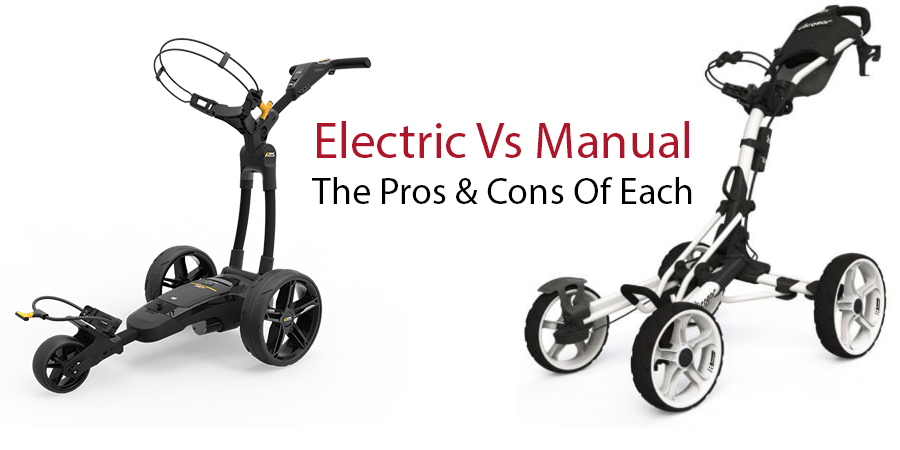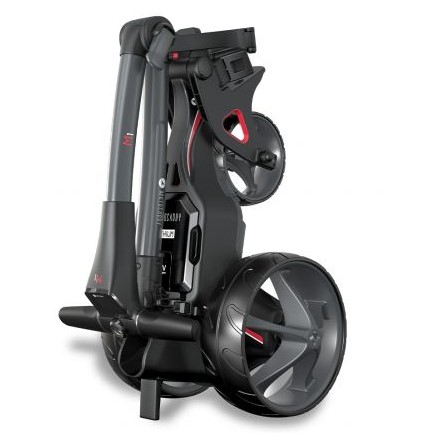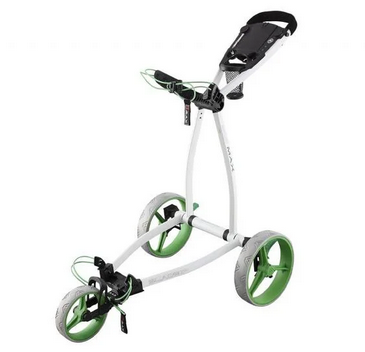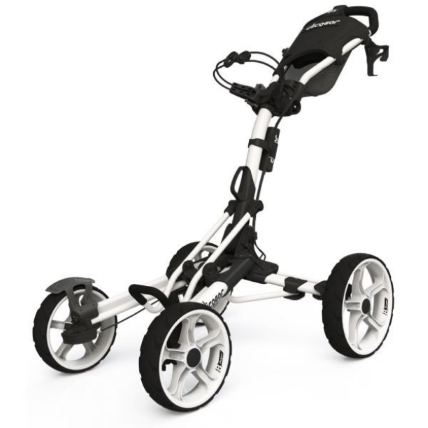As the total yardage for large golf courses in the UK can exceed 7000 yards, with an average length golf course alone in the 6500 range, using a golf trolley can significantly improve a player’s golfing experience on the course, from helping to reduce physical exertion to playing an active role in a game strategy.
In this article, we will firstly provide a broad overview of the two main types of golf trolley; we will then delve deeper outlining the pros and cons of both an electric golf trolley and a manual push trolley.
If you want to be well informed and make the correct purchasing decision when it comes to a golf trolley, we recommend reading our resourceful article.

Golf Trolleys – An Overview
A golf trolley is a specialized piece of equipment manufactured to carry a golfer’s bag on the course. The trolley is sturdy enough to carry the weight of a full bag containing a set of golf clubs, balls, accessories and clothing which may be more than 13 Kilos (15 pounds).
Using a golf trolley allows a player to conserve all their energy for the game dedicated to both shot making and on-course strategy compared to expending energy lugging heavy golf equipment for potentially 4 hours or more during a playing round.
There are two main types of golf trolley which are manual push and electric trolleys.
Manual Push Golf Trolleys
Push golf trolleys, also known as manually operated golf trolleys require you to push or pull them around the golf course. They tend to work best on flatter courses where less effort is required to move them and although a significant improvement on carrying your own golf bag they do require some physical effort especially on an undulating course.
Electric Golf Trolleys
An electric golf trolley is a battery-operated transportation system for your golf bag that requires no physical effort on the part of the golfer. Over the duration of a golf round, its motor will move your equipment around the course seamlessly with you simply pressing an accelerator on the handle, with some models even allowing for control with a remote.
A helpful video on what is the better choice – An electric or a push trolley
The Pros Of Using An Electric Golf Trolley
There are three principal advantages of using an electric golf trolley and we will look at each one in turn:
Energy Conservation
A key advantage of electric golf trolleys is they require less physical effort to operate than a manual push trolley. This benefit is especially beneficial during a long round, as it allows you to conserve energy for your swing rather than depleting it on moving heavy equipment around the course.
Ideal for Hilly Courses
Electric golf trolleys have powerful motors that will easily handle slopes and undulating terrain. It makes them a great choice for hilly golf courses where pushing or pulling a manual trolley will become strenuous. The motor does the hard work, allowing you, the golfer to focus on your game.

Additional Features
Electric golf trolleys typically have a range of additional features to enhance the golfer’s on-course experience. Depending on the price point, this may include a GPS system for smooth navigation around the course, a distance measurement tool to accurately count calculate the yardage of each shot, and even USB ports for charging devices like smartphones or rangefinders.
These features not only add convenience but also can help improve a golfer’s game by providing valuable data and keeping devices fully charged throughout a round.
The Cons of Electric Golf Trolleys
Despite, the undoubted benefits highlighted above of using an electric golf trolley, there are some disadvantages which we should highlight:
Higher Purchase and Ongoing Costs
The advanced technology and mechanical parts of an electric golf trolleys make them more expensive than a manual push trolley. Any initial investment in the trolley does not factor in battery issues that may arise and potentially its replacement over time. Furthermore, electric trolleys may require more maintenance, adding to the overall cost over time.
Battery Dependent
Electric golf trolleys need a rechargeable battery to power the motor which can pose a risk if the battery runs out of power or dies during a round. This battery dependency means a golfer needs to ensure the battery is fully charged before each round.
Additionally, batteries have a lifespan, typically of 1500 to 2000 charges for lithium-ion batteries (read our lithium battery guide to find out more) and will need to be replaced over time, which is an additional cost to consider.
Weight and Portability
Electric golf trolleys, due to the motor, battery and other components like clutches, brakes and GPS systems are typically heavier than manual trolleys. The increased weight does make them less portable and more challenging to manoeuvre in and out of your car or around the golf course. Depending on the brand and model they may also be bulkier due to advanced features or added components that may require more storage space.
The Pros Of Using A Manual Push Golf Trolley
Manual push golf trolleys are powered by the physical effort of a golfer with no motorized assistance available. They are designed to be both pushed or pulled around the golf course, carrying the golfer’s bag over the duration of a round.

Cost-Effective
One of the main advantages of manual push golf trolleys is affordability. Omitting the need for advanced technology or electric motors, push trolleys are typically less expensive than electric golf trolleys.
Manual trolleys are a great choice for golfers on a budget or those just starting out in the sport who are uncertain whether to invest heavily in equipment they may not need at an early stage.
No Battery Required
Manual push golf trolleys operate purely on manual power, eliminating the need for a battery. This means golfers don’t have to worry about charging a battery before each game or the risk of a battery dying mid-course. It also removes the potential cost and hassle of battery replacement.
Lightweight and Compact
Manual push golf trolleys are typically more compact and lighter than electric models, making them easier to store and transport. The lightweight design makes them easy to push around the course, and a compact folded size means they take up less space in your car or in storage.
The lightweight and compact design It can be a significant consideration for golfers who travel frequently or have limited storage space.
The Cons Of Manual Push Golf Trolleys
The shortcomings of a manual push trolley are most evident in the following two ways.
Increased Physical Effort
The obvious disadvantage of manual push golf trolleys is the physical effort required from the golfer. Unlike an electric trolleys that uses a motor to move, a manual trolley relies on the golfer’s strength to push or pull them around the course.
It can be tiring, especially during a lengthy round or on an undulating golf course. Especially in the latter part of the round, the additional exertion may lead to fatigue which will affect the golfer’s performance.
Lack of Advanced Features

Manual push golf trolleys typically come with fewer functions and features compared to an electric golf trolley. Manual trolleys lack advanced features such as:
- In-built GPS systems for on-course navigation
- Distance measurement tools
- USB ports for charging devices
- Remote controls
- Electronic Brake Systems
- Speed Control
- Follow Systems
While these features may not be necessary for all players, they can add convenience and in professional tests have been proven to improve the golfing experience for those who use them. We have written a detailed article on the key benefits of using an electric golf trolley and the enhanced golfing experience.
Players opting for a manual push trolley should prepare for a more basic, less tech-enhanced golfing experience.
Comparing A Manual Versus An Electric Golf Trolley
When comparing electric and manual push golf trolleys, it is vital to base the comparison on easily quantifiable factors that allow for an informed purchasing decision according to your needs as a golfer. Here at Electric Golf, we consider the following comparative factors as the most important to make the correct purchase:
Performance Comparison
Is improving your performance by lowering your handicap on the course a key reason for purchasing a trolley? If so we think an electric golf trolley is your better option.
- Electric golf trolleys generally outperform manual push trolleys in ease of use and additional features. The electric motor allows for effortless transport of equipment across the course which conserves your energy for shot making and on-course strategy. Additionally, electric trolleys often come with advanced features such as electronic brake systems, cruise control, GPS systems and distance measurement tools that enhance the golfing experience.
- Manual trolleys do require more physical effort from the golfer and lack the advanced features found in electric models. However, manual push golf trolleys are more reliable as they do not rely on a battery for propulsion, only human effort. There is no risk of a battery failing during a round and they are less likely to require repairs related to motor or battery issues.
Cost Comparison
If keeping down the cost of not having to carry your golf bag rather than as a tool to improve your on-course performance then a push trolley is a sensible consideration.
- Electric golf trolleys are typically more expensive due to the advanced technology and mechanics involved. The initial investment is higher, and there may be ongoing costs related to battery replacement and maintenance. An original replacement battery for a Motocaddy or Powakaddy can retail between £250 and £300, with non-OEM (original equipment manufacturer) lithium batteries still costing over £100.
- In contrast, manual push golf trolleys are more budget-friendly. They are cheaper to purchase, with even top of the range push trolleys like the Clickgear 8.0 retailing for under £300. For £300 you will just about get an entry level electric golf trolley from Ben Sayers with a lead acid battery and limited features. Furthermore, without a battery or a motor to worry about, ongoing maintenance costs for a push trolley are pretty much zero.
Suitability for Different Golf Courses
There are broadly six different types of golf courses. If you play regularly on a hilly course with undulating terrain, perhaps on a woodland or links course, the reason to purchase an electric golf trolley over a push trolley is compelling.
- Electric golf trolleys are ideal for hilly courses as the motor makes it easy to navigate slopes and uneven terrain, conserving the golfer’s energy. Furthermore, some electric golf trolleys have built in electronic braking systems and downhill speed control for ultimate control on undulating slopes.
- Conversely, manual push golf trolleys work best on flatter courses. Without slopes to navigate, the physical effort required to push the trolley is minimized, reducing the advantage of purchasing an electric golf trolley.
Conclusion
What this article has established is both manual push golf trolleys and electric golf trolleys each have their own unique pros and cons. Your decision of which one to choose may include:
- Your personal preference as a golfer
- Your ambition as a golfer
- Your physical condition
- The type of golf course you play on
- Your budget.
We would like to best summarize by saying, the best golf trolley is the one that will enhance your golf experience according to your needs.
Good luck and happy golfing – The team at Electric Golf where our moto is “Focus on your golf, not your fitness”
FAQs
Can you use an electric golf trolley without the battery plugged in?
- Electric golf trolleys do require a battery to operate on a motorized basis. If the battery does lose completely during a round , you can still push it manually, although the weight of the trolley may make it uncomfortable to do so.
How much weight can a manual or electric golf trolley carry?
- The weight a golf trolley can carry depends on the model. Whether manual or electric, most can comfortably carry a standard golf bag filled with clubs and other equipment which on average weighs 13 to 15 kg. Always check the manufacturer’s specifications to ensure it meets your needs.
